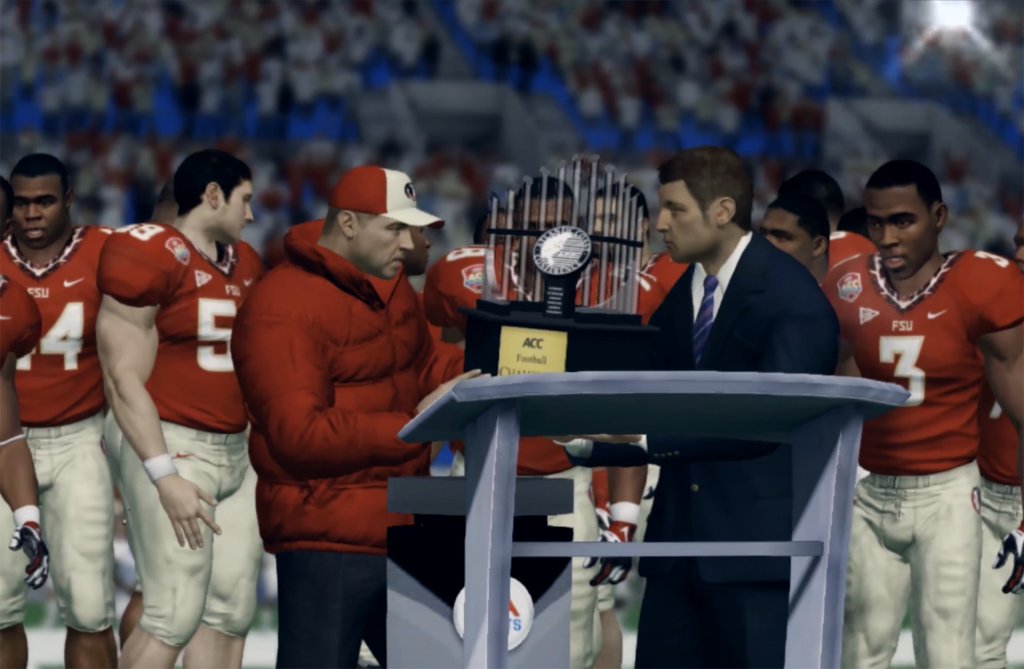Here we are in College Park, Maryland, with just under seven minutes left in the first half of a contest between the University of Maryland Terrapins and the visiting Big Ten stalwarts, the Ohio State Buckeyes. Ohio State is already up 24-3, on its way to a brutal 52-24 canning of the home team, when running back Ezekiel Elliott catches a swing pass in the flat for five yards. It is an unremarkable play in every regard but Elliott’s fashion choices.
Elliott, abs on display for all of College Park and the ABC audience at home to see, is announcing the return, in no uncertain terms, of the midriff-baring football jersey. Not a jersey tailored too tight to contain the gut of an offensive lineman but one rolled deliberately, and with great purpose, tucked in below the pads to display the steel belting underneath.
Videos by VICE
Read More: The NCAA’s Weed Policy Is A History Of Ignorance
The look is, without a doubt, virile when flaunted by athletes like Elliott or UCLA wrecking ball Myles Jack; particularly in comparison to the men perched, haunched, flopped, and standing before their televisions each Saturday who can only imagine such physiques in the same dream state they reserve for the personal fantasies of touchdown passes and draft day suits and the egotistical, financial, and corporeal rewards such pinnacles of masculinity reap.
In a sport with no shortage of muscle but a notable dearth of flesh, it provides a flash of surreal humanity. The chiseled midriff stands in stark juxtaposition to the pads directly above it, which hang like a crab’s shell across the player’s shoulders, and to the helmeted and hidden faces, glove-veiled hands, and other various pieces of equipment that cause football players to resemble automatons, as opposed to humans. The midriff gives tangible representation to the sexual connotations of football’s brute force and its language: penetration, hammered, sack.
As with all things fashion, the midriff-baring jersey is cyclical in nature; when Elliott pops up after the play, one can squint and see a fleeting vision of another Ohio State running back, Eddie George, whose own midriff baring brought to mind a previous generation of players who wore the style.

Eddie George flashing some abs for OSU. Photo by RVR Photos-USA TODAY Sports
“I look more to the 70s than Eddie George … it was a very popular look back then,” said Paul Lukas, the main engine behind the UniWatch blog and the same-named ESPN column. For Lukas, that the crop top presents itself again and again is part of a larger collegiate styling, a looseness that keeps it separated from the pros.
“College football has always had a few things that mark it as being visually different from pro football,” Lukas said via phone, including the crop top, which is itself part of a larger, skimpier intercollegiate look. “Many college teams—I’ve never really tabulated whether it’s more than half—but certainly many college teams, the players go barelegged, whereas in the pros, ever since the 40s, it’s been mandatory to wear high socks.”
This latest midriff return is of specific interest because it may also mark a shift in the protective tendencies of current players. “One reason the look went away is that the pads and other equipment the players wear now extends much further down the torso,” Lukas said. “It used to be you’d wear a pair of shoulder pads and that’s it.”
Fashion is an expression of culture, football culture included, and such observations can open a litany of subjective and pop-psychological insights; perhaps a flaunting of the belly, traditionally among the most vulnerable of targets, sans protection is a subconscious push back against the supposed “softening” of the sport, a blood-haze posturing in the face of fearful concussion knowledge. Or it could be peacocking in the classical sense—these abs are, after all, highly lusted after, body-image skewing attributes of supposedly ideal masculinity.
What is certain is that the pragmatic performance benefits are negligible; while rolling the jersey up may result in better ball control and increased heat dissipation, the main benefit is that men with midsections like this leave little for would-be tacklers to latch on to.
“The question you posed is an interesting one,” UNLV professor of kinesiology James Navalta wrote via email when asked the performance benefits of the crop top. “In addition to the evaporative cooling benefits (which would be minimal unless the individual sweats at a greater rate at the midriff), the only other thing that I could think of is that it would be [one] less place for a defender to grab on to while attempting to make a tackle (it could be possible that a defender could grab hold of shirt fabric while a bare midriff would reduce that possibility).”
Lukas agreed; “If you have any bare skin without a jersey on it, you can’t tackle what isn’t there.” But there is a caveat: “On the other hand, if there’s an edge that isn’t tucked in, like where the point at which the cropping, the hemline, basically, that seems to me something that would be easier to grab if there’s an edge. I think those two things might sort have canceled each other out.”
Of course, actual empirical evidence of performance enhancement means little when put up against an athlete’s mental state; if Jack truly believes that he can shed that block easier with nothing but the grooves between his abs for a defender to grab onto, he will certainly play better. The real answer likely lies in a conflation of performance and pride, the same forces which conspired to all but eliminate the football sleeve, leaving both nothing to grab on to and nothing to obfuscate the bulging musculature of the arm.
As for the players themselves, Elliott, with a large smile spreading across his face, spoke on people’s reactions to his sartorial choices.
“Some people like it. Some people don’t like it. I like a little midriff showing.”



